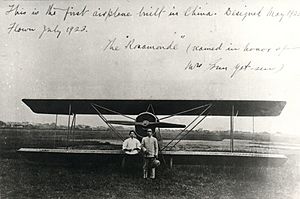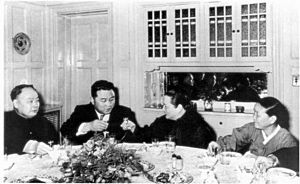Soong Ching-ling facts for kids
Quick facts for kids
Madam
Rosamond Soong Ch'ing-ling
|
|
|---|---|
|
宋庆龄
|
|
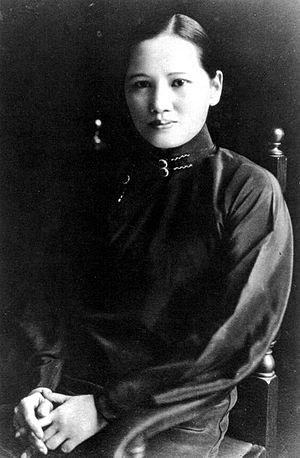 |
|
| Honorary Chairwoman of the People's Republic of China | |
| Appointed by | the Standing Committee of the 5th National People's Congress on 16 May 1981 |
| Premier | Zhao Ziyang |
| Leader | Deng Xiaoping and Chen Yun |
| 2nd Vice Chairperson of the People's Republic of China | |
| In office 27 April 1959 – 17 January 1975 Served alongside Dong Biwu during the 2nd and 3rd National People's Congresses |
|
| President | Liu Shaoqi vacant (1968–1972) Dong Biwu (Acting) |
| Preceded by | Zhu De |
| Succeeded by | Ulanhu (1983) |
| Chairwoman of the People's Republic of China | |
| In office 31 October 1968 – 24 February 1972 Co-acting alongside Dong Biwu as Vice Chairpersons of the People's Republic of China during the 3rd National People's Congress |
|
| Premier | Zhou Enlai |
| Leader | Mao Zedong |
| Preceded by | Liu Shaoqi (as Chairman) |
| Succeeded by | Dong Biwu (as Acting Chairman) |
| In office 6 July 1976 – 5 March 1978 As acting Chairwoman of the Standing Committee of the 4th National People's Congress |
|
| Premier | Hua Guofeng |
| Leader | Hua Guofeng |
| Preceded by | Zhu De (died in office) |
| Succeeded by | Ye Jianying |
| Vice Chairperson of the Standing Committee of the National People's Congress | |
| In office 17 January 1975 – 29 May 1981 4th and 5th National People's Congresses |
|
| Chairman | Zhu De (died in office) Ye Jianying |
| In office 15 September 1954 – 18 April 1959 1st National People's Congress |
|
| Chairman | Liu Shaoqi |
| Vice Chairperson of the Central People's Government | |
| In office 1 October 1949 – 27 September 1954 Served alongside Zhu De, Liu Shaoqi, Li Jishen, Zhang Lan, Gao Gang |
|
| Chairman | Mao Zedong |
| Preceded by | Government established |
| Succeeded by | Zhu De (as Vice Chairman of the PRC) |
| Personal details | |
| Born | 27 January 1893 Shanghai International Settlement |
| Died | 29 May 1981 (aged 88) Beijing, People's Republic of China |
| Cause of death | Leukemia |
| Political party | Kuomintang (1919–1947) Communist International (1930s–1943) Revolutionary Committee of the Chinese Kuomintang (1948–1981) Chinese Communist Party (1981) |
| Spouse | Sun Yat-sen (1915–1925) |
| Parents | Charlie Soong and Ni Kwei-tseng |
| Alma mater | Wesleyan College |
| Soong Ching-ling | |||||||||||||||||
|---|---|---|---|---|---|---|---|---|---|---|---|---|---|---|---|---|---|
| Traditional Chinese | 宋慶齡 | ||||||||||||||||
| Simplified Chinese | 宋庆龄 | ||||||||||||||||
|
|||||||||||||||||
Rosamond Soong Ch'ing-ling (born January 27, 1893 – died May 29, 1981) was an important Chinese political leader. She was the third wife of Sun Yat-sen, who was a key figure in China's history. He led the Kuomintang (Nationalist Party) and was the first President of the Republic of China. Because of her marriage, she was often called Madame Sun Yat-sen.
Soong Ch'ing-ling was part of the famous Soong family. She and her sisters played a big role in Chinese politics both before and after 1949. After the People's Republic of China was formed in 1949, she held many important jobs. These included Vice Chairperson and Vice Chairperson of the Standing Committee of the National People's Congress. She also traveled to other countries, representing China at international events.
During the Cultural Revolution, a difficult time in China, she faced some criticism. Later, she became the acting Head of State for a period. Before she passed away in May 1981, she was given the special title of "Honorary President of the People's Republic of China". Soong Ch'ing-ling was the first female head of state in modern China.
Contents
Early Life and Marriage
Soong Ch'ing-ling was born in Shanghai. Her father, Charlie Soong, was a businessman and missionary. She was the second of six children. She went to school in Shanghai and then studied in the United States at Wesleyan College. She spoke English very well because she was educated in English for most of her life. Her Christian name was Rosamonde.
Soong Ch'ing-ling married Sun Yat-sen on October 25, 1915. Sun Yat-sen was a leader of China's 1911 revolution and started the Kuomintang party. Her parents did not approve of the marriage because Dr. Sun was 26 years older than her.
After Sun Yat-sen died in 1925, Soong Ch'ing-ling was chosen to be part of the Kuomintang's main committee. However, she later left China and went to Moscow. This was after the Communists were removed from the Kuomintang in 1927. She felt the Kuomintang had not followed her husband's ideas.
Her younger sister, May-ling, married Chiang Kai-shek. This made Chiang Kai-shek her brother-in-law.

Soong Ch'ing-ling came back to China in June 1929. She returned again in July 1931 when her mother passed away. She lived in Shanghai until July 1937, when the Second Sino-Japanese War began. During the war, she moved to Hong Kong and then to Chongqing. In 1939, she started the China Defense League. This group raised money and supplies, mainly for areas controlled by the Chinese Communists in northern China. In 1946, the group changed its name to the China Welfare Fund. It continued to support the Chinese Communists.
Role in the New China
During the Chinese Civil War, Soong Ch'ing-ling decided to support the Communists. She became an honorary leader of the Revolutionary Committee of the Chinese Kuomintang. This was a group that believed they were the true followers of Sun Yat-sen's ideas.
When the Nationalist government fell and the Communists won the civil war, she went to Beijing in September 1949. She attended a meeting held by the Chinese Communist Party to set up a new government. On October 1, she was a guest at the ceremony in Tiananmen Square. This event marked the beginning of the new People's Republic of China.
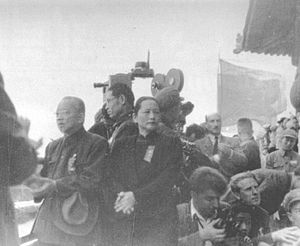
Soong Ch'ing-ling was highly respected by the Communists. They saw her as a link between their movement and Sun Yat-sen's earlier work. After the People's Republic of China was officially formed in 1949, she became one of the six vice chairpersons of the Central People's Government. She also became a vice chairperson of the Sino-Soviet Friendship Association. In 1951, she received the Stalin Peace Prize.
In 1950, Soong became the leader of the Chinese People's Relief Administration. This group helped with welfare and relief efforts. Her China Welfare Fund became the China Welfare Institute. It started publishing a magazine called China Reconstructs, which is now known as China Today. In 1953, a book of her writings, Struggle for New China, was published.
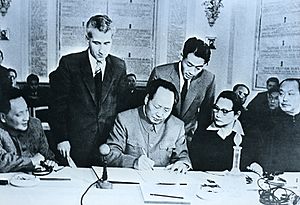
In 1953, Soong helped prepare for elections to the new National People's Congress. She also helped write the 1954 constitution. She was elected to the first National People's Congress. In September 1954, she became one of the 14 vice-chairpersons of the NPC's standing committee. She also became a vice-chairwoman of the CPPCC. During this time, Soong traveled to many countries, including the Soviet Union, India, and Indonesia.
Important Roles and Later Years
In April 1959, Soong Ch'ing-ling was again elected to the 2nd National People's Congress. At this meeting, Liu Shaoqi became the State Chairman (President). Soong Ch'ing-ling and Dong Biwu were elected Vice Presidents of China. She was re-elected as Vice-chairperson of the PRC in 1965. She often appeared at important events, welcoming visitors from other countries.
During the Cultural Revolution (1966–1976), Soong faced some criticism. However, Premier Zhou Enlai made sure she was protected. Her term as Vice President of China ended in January 1975. After that, she was again appointed as one of the vice-chairwomen of the NPC Standing Committee.
Soong's public appearances became less frequent after the Cultural Revolution. She was also not in good health. However, she continued to write articles, especially about children's welfare. Her last public appearance was on May 8, 1981. She accepted an honorary degree from the University of Victoria. A few days later, she became very ill. On May 16, 1981, shortly before her death, she was made an Honorary Chairwoman of the People's Republic of China. She is the only person to have ever held this title.
Museums and Legacy
Soong Ch'ing-ling wanted her remains to be placed next to her parents' grave. This was done at Shanghai's International Cemetery, which is now called the Soong Ching-ling Memorial Park.
Several of her former homes have been turned into museums:
- In Shanghai, the house where she lived with Sun Yat-sen from 1918 to 1937 is now the Former Residence of Sun Yat-sen. It shows some of her belongings from their time together.
- Another house in Shanghai, where she lived from 1948 to 1963, is now the Soong Ching-ling Memorial Residence. It has a memorial hall with her items and photos. The main building and gardens are kept as they were, with original furniture.
- In Beijing, a mansion where she lived from 1963 until her death is now the Former Residence of Soong Ching-ling. It is a museum that shows her rooms and furniture as she used them.
Family Connections
Soong Ch'ing-ling was part of the famous Soong family. Her sisters were Soong Ai-ling and Soong Mei-ling. Her brother was T. V. Soong. This family was very influential in China's history.
See also
 In Spanish: Soong Ching-ling para niños
In Spanish: Soong Ching-ling para niños



